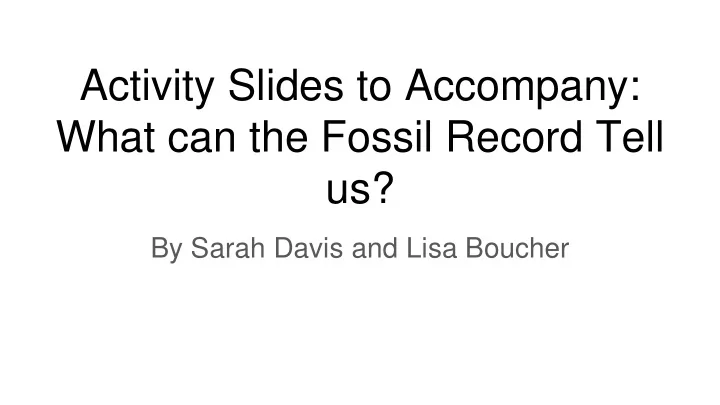

Activity Slides to Accompany: What can the Fossil Record Tell us? By Sarah Davis and Lisa Boucher
Preface: The following slides contain information on a field site, images of fossils, and fossil reconstructions that are meant to accompany the word document activity. Each student should use the slide information and images to help answer the questions in the activity. The reconstructed versions of each organism can be shown along with the fossil images, or for older groups of students can be withheld until the end of the activity and used as a key- older groups can be asked to hypothesize what these fossils may have looked like in life, and to draw their own reconstructions based on the fossil images.
Activity Instructions: You are a paleontologist, working with a team to excavate fossils from a site and reconstruct and interpret the ancient environment. On your own or with a group, look at the images of the fossils that have been excavated so far. Use the questions in the activity to begin interpreting the environment all of these organisms used to live in.
You are a paleontologist! You and your team have been working to excavate a Late Cretaceous (100 - 66 million year old) site, and have recovered lots of interesting fossils! Your job now is to use information about the field site and the fossils themselves to reconstruct what this ancient environment used to look like, and how the organisms you’ve found might have interacted.
Information on your site: You are working in Southwestern Texas! The rocks range in age from 100-66 million years old (the Late Cretaceous) Rocks here mostly represent marsh, Your field site lake, river, and shallow sea environments.
What your field site looks like today:
The field site has a few environments preserved lake The rock record can have an effect called “time averaging”, where fossils from several different periods of time can be preserved in one location. marsh This field area has been well studied, so your team already knows that there are terrestrial (lakes, marshes) and marine (shallow sea) environments represented shallow marine around the area. Your job is to figure out which fossils come from which environment, and to imagine how those organisms interacted in life.
The site has a mix of non-vertebrate and vertebrate fossils Using these fossils, you will reconstruct the ancient environment. ● Non-vertebrate fossils include plants and invertebrate animals (such as insects, and other soft bodied animals). ● Vertebrate fossils are of animals with skeletons, like dinosaurs.
Note : It is very rare to find in-tact, perfect specimens. The images of fossils you’ll see are beautifully preserved or are reconstructions, so while you look at them also think about the conditions you could actually find fossils in. Here are some examples of what fossils look like when they’re found in the field: Shelled invertebrates A mosasaur jaw with teeth A dinosaur leg bone
The Non-Vertebrate fossils: Cupressinoxylon wood - Conifer trees have spiky needles, and their seeds are contained in cones. They were very common during the Cretaceous and were a food source for many dinosaurs. Nelumbonaceae leaf- This is a group of aquatic flowering plants that include the modern day Lily pads.
The Non-vertebrate Fossils Conlinoceras - This is a species of ammonite, a group of extinct cephalopods closely related to living octopi and squids. Their hard shell protected a soft bodied, tentacled animal. Exogyra- These saltwater bivalves are filter feeders, and catch floating organisms to feed on. They
The Vertebrate Fossils: Tyrannosaurus rex - This dinosaur reached up to 20 ft tall and ran across North America on two powerful legs. From the fossil we can tell that it had long, dagger-like teeth and sharp claws. There are also lots of marks on the dinosaur that look like bites from other dinosaurs. Hesperornis- This bird stood 6 ft tall, and had powerful hind legs and feet that likely looked like those of living ducks. However, this bird had tiny wings, and its long beak looked very different from the birds we see today: it had sharp, pointed teeth!
The Vertebrate Fossils: Mosasaurus- This large swimming reptile might remind you of living whales and dolphins, but they are actually closely related to living snakes and lizards. These marine predators could reach 50 ft long, and had powerful flippers to propel them through the water. Hadrosaur- Hadrosaurs were a common type of dinosaur that lived in North America. They walked on four legs, are thought to have lived in groups, and had very short, stubby teeth. Many fossils of hadrosaurs have bite marks on them that match the teeth of predatory dinosaurs.
Reconstructions of the Fossils
Cupressinoxylon Nelumbonaceae
Conlinoceras Exogyra
Tyrannosaurus rex Hesperornis
Mosasaurus Hadrosaur
Reconstructions of the Environments These are example reconstructions made by professional paleo artists (artists who specialize in reconstructing the past). There are many options on how to show these environments, and no one answer!
A marshy environment Large dinosaurs (the Tyrannosaurus and the Hadrosaur) in a marsh or forest. The hadrosaur may be eating some of the plants, while the Tyrannosaurus watches.
Marine environment In the marine environment there is likely lots of fishing activity taking place. The Hesperornis is likely catching fish, and maybe the Mosasaurus is also hunting fish or even the hesperornis.
Near the seashore You can also interpret the environment as being close to the ocean shore! Dinosaurs could have walked along the beach and left tracks in the sand.
Recommend
More recommend